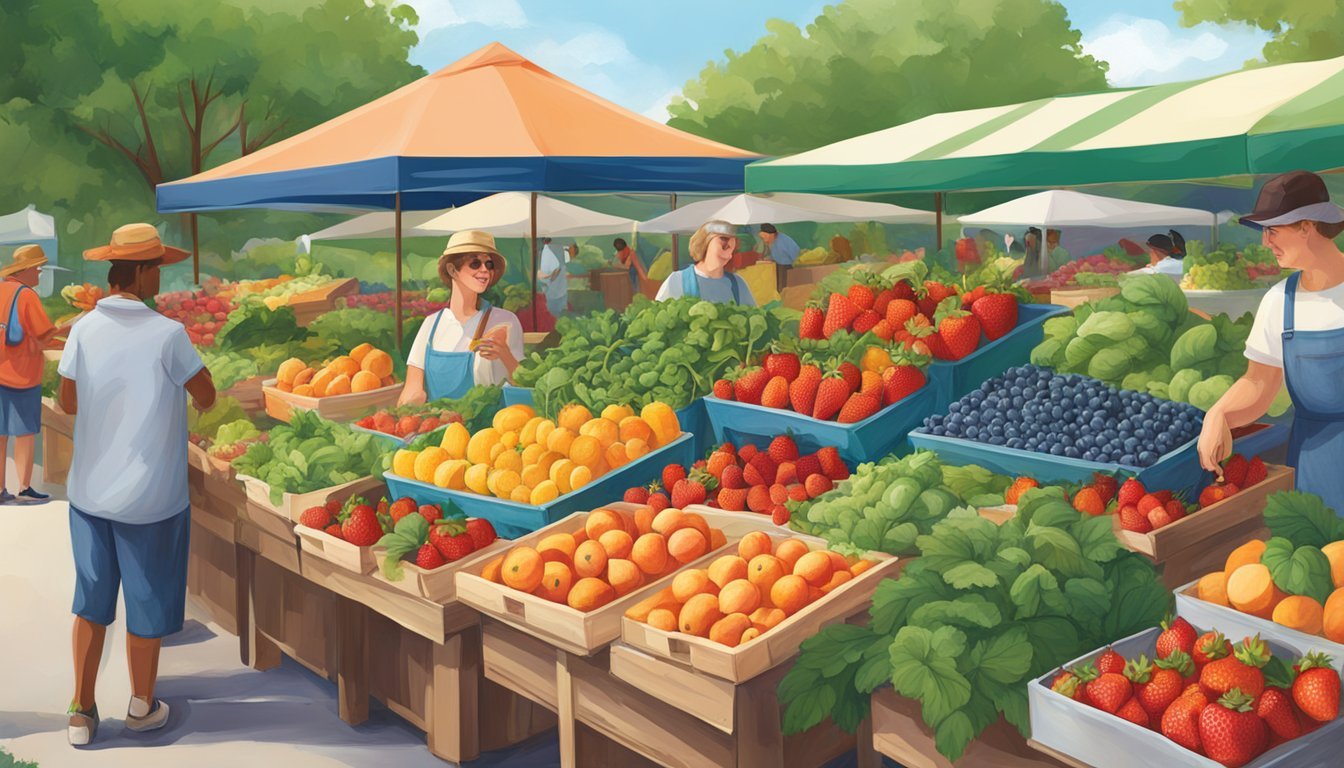Alabama Seasonal Fruit & Vegetables in April
A Guide to Spring Harvest
This Article is Part of our Alabama Seasonal Fruit & Veg Calendar
As spring unfurls in Alabama, April emerges as a month of abundant growth and renewal. The state's farms and gardens begin to offer a colorful array of fresh fruits and vegetables. Alabama's temperate climate and fertile soil provide ideal growing conditions that contribute to the local agricultural economy and the variety of produce available. April's selection of farm-fresh produce not only supports healthy eating but also encourages culinary exploration with the change of seasons.
During this month, consumers can indulge in an assortment of plump, ripe fruits. Strawberries, a beloved springtime berry, reach their peak in Alabama, offering juicy sweetness that is perfect for a range of dishes, from classic desserts to innovative salads. Vegetables are not to be overlooked, as April heralds the arrival of crisp greens and tender varieties. Leafy staples like spinach, kale, (What wine goes well with kale?) and assorted lettuces, as well as hearty vegetables like broccoli (how long does broccoli last?)and radishes, grace the tables with vibrancy and nutrition.
The local markets and roadside stands across Alabama in April showcase the state's agricultural richness. Residents and visitors alike have the opportunity to relish in the fresh tastes of the season and appreciate the hard work of local farmers. As the growing season progresses, one can expect the availability of produce to evolve, reflecting the dynamic nature of Alabama's agricultural landscape.
Seasonal Fruits Overview
April in Alabama brings the beginning of a vibrant fruit season, with an array of choices starting to become available to consumers. This period is characterized by the emergence of early berries and the tail end of citrus fruits, and while stone fruits and melons are not yet at their peak, there are signs of their impending arrival.
Berry Varieties
The dawn of spring brings with it the berry season in Alabama. Strawberries make a particularly strong appearance in the market due to their earlier start, usually peeking in April. They are often the first fruit to make it to the tables after winter, tantalizing with their ripe red freshness. Blueberries, on the other hand, have not quite reached their full season but may start to appear towards the end of the month, hinting at the bountiful harvests that are to come in the following months.
Citrus and Stone Fruits
While April is not the prime time for citrus and stone fruits in Alabama, there can still be remnants of citrus, such as oranges, which are just rounding off their season. These fruits should be enjoyed quickly as they make their departure from the seasonal scene. Meanwhile, the highly anticipated peaches are drawing closer to their season, with early varieties beginning to show in markets by the end of the month. Their sweet fragrance and fuzzy skin become an indicator of the summer harvests that await.
Melon Seasonality
Melons, including watermelon, are synonymous with summer and are not typically harvested in April. Watermelons require warm weather to sweeten and are usually harvested later in the summer. Nonetheless, the preparation and planting of these fruits often begin during this month, laying the groundwork for their peak seasons to follow.
Seasonal Vegetables Guide
In Alabama, April heralds the arrival of spring produce with a range of vibrant and nutrient-packed vegetables. This guide provides a snapshot of the vegetables available, focusing on leafy greens and brassicas, root vegetables and tubers, as well as pods and seeds that are in season.
Leafy Greens and Brassicas
This category brings nutritious options to the table with a variety of textures and flavors. Gardeners and farmers alike will harvest a bountiful selection of leafy greens including:
Lettuce: Offering a mix of types such as butter, leaf, and romaine.
Kale: Known for its hearty leaves and nutritional value, making a great addition to any meal.
Aiding in the transition from winter to spring, these greens are perfect for fresh salads or sautéed side dishes.
Root Vegetables and Tubers
Both hardy and flavorful, root vegetables are a staple in Alabama's April produce. Among them, you will find:
Radishes: Crisp and peppery, quick to mature and ready for harvest.
Carrots: Sweet and crunchy, a versatile vegetable for both raw and cooked dishes.
These underground treasures are excellent for adding a pop of color and a punch of flavor to spring menus.
Pods and Seeds Group
Legumes make their way into April's planting and harvesting schedules. High in protein and fiber, they include varieties such as:
Beans: With types like snap beans becoming available later in the season.
Peas: Garden peas and snap peas are prime for picking and add a sweet taste to any dish.
Pods and seeds are not only nourishing but also bring a variety of options to the garden and kitchen.
Harvest and Flavor Notes
In April, Alabama offers a variety of seasonal fruits and vegetables that boast peak freshness and flavor. This time of year, the produce harvested has a rich nutrient profile due to the soil's fertility and the region's growing conditions.
Vegetables:
Broccoli: It tends to have a more tender stem and a robust flavor due to the transitional weather of early spring.
Collard greens (how long do collard greens last?): Known for their slightly bitter taste, which is milder when harvested in cooler temperatures.
Turnip greens: These have a spicy, peppery punch that is both nutritious and flavorful.
Fruits:
Strawberries: April marks the beginning of the strawberry season, with berries being especially sweet and juicy.
Produce Flavor Profile Nutritional Benefits Broccoli Robust, slightly bitter High in vitamin C and K, fiber-rich Collard greens Mildly bitter, earthy Rich in vitamins A, C, and K, calcium, iron, and antioxidants Turnip greens Spicy, peppery Good source of vitamin A, C, K, calcium, and fiber Strawberries Sweet, juicy High in vitamin C, manganese, and antioxidants
Local markets are an excellent source for these fresh, seasonal offerings, ensuring consumers receive produce at its flavorful best. Alabama's growers emphasize that freshly picked fruits and vegetables not only taste better but also retain higher nutritional value, supporting overall health and wellness.
Gardening Tips for April
As April ushers in warmer temperatures in Alabama, gardeners should focus on proper planting techniques and garden maintenance to ensure a bountiful harvest.
Planting Strategies
In April, gardeners should plant small seeds such as turnips and carrots approximately 1/4 to 1/2 inch deep, and larger seeds like beans, cucumbers, and peas should be sown about 1 inch deep. It's paramount to select stocky, healthy plants for transplanting and to water them immediately after to establish a solid root system.
Maintenance and Pruning
Pruning is crucial during April to maintain the health of shrubs and trees. Snip off any dead or damaged branches to prevent disease spread and encourage new growth. In April's garden, regular weed control is essential to limit competition for nutrients and water. Gardeners should check and maintain the correct soil moisture levels, particularly after planting, to ensure seeds have the best conditions for germination and growth.
Health Benefits and Nutrition
Consuming fruits and vegetables that are in season in Alabama during April offers not only peak flavors but also substantial health benefits due to their high nutritional content.
Fiber: Seasonal produce provides essential dietary fiber that aids in digestion, helps control blood sugar levels, and maintains a healthy gut. Vegetables like spinach and lettuce, as well as fruits that come into season, are excellent sources of fiber.
Minerals: The soil in Alabama nourishes its produce with a range of minerals necessary for good health. For instance, collard greens and kale are packed with calcium and iron, supporting bone health and oxygen transportation in the blood.
Variety: Embracing the variety of fruits and vegetables available in April can lead to a more diverse intake of essential nutrients. Each type of produce comes with its unique set of vitamins and minerals, contributing to a well-rounded diet. Eating a variety encourages not only nutritional balance but also adds different textures and flavors to meals.
Produce Notable Nutrients Broccoli Vitamin C, Vitamin K, Folate Mustard Greens Antioxidants, Vitamin A, Vitamin K Turnip Greens Vitamin A, Vitamin C, Calcium Spinach Iron, Magnesium, Vitamin A
Including seasonal produce in one's diet should complement other food groups to support overall health. They tend to be lower in calories while being nutrient-dense, which can support weight management and overall well-being.
Recipes and Preparation
When it comes to enjoying Alabama's April produce, creativity in the kitchen can lead to delicious outcomes. Strawberries and asparagus (how long does asparagus last?) are prime examples of seasonal produce that can be transformed into a variety of dishes.
Strawberry Cobbler The sweetness of strawberries can be showcased in a classic Strawberry Cobbler, perfect as a dessert. They simply need to be hulled, halved, and tossed with a bit of sugar and lemon juice, then topped with a buttery biscuit crust before baking to golden perfection.
Asparagus Fresh asparagus, another April gem, can be roasted, grilled, or steamed. One could make a vibrant side dish by tossing the spears in olive oil with a pinch of salt and roasting them for about 15 minutes at 400°F (200°C).
Produce Storage Tips Cooking Method Strawberries Refrigerate and wash just before use. Best for: Baking, Salads Asparagus Keep in a damp towel in the fridge. Great when: Grilled, Roasted
For optimal freshness, store these items properly. Strawberries should be kept in the refrigerator and only rinsed just before you plan to use them to prevent mold. As for asparagus, wrapping the ends in a damp paper towel before refrigerating them can maintain their crispness.
Whether tossed into a salad or made into a hearty entrée, these ingredients can be at the heart of any meal. It is best to keep preparation simple to highlight their natural flavors. Less is more when produce is at its peak of freshness.
Buying Local: Alabama's Farms
In April, consumers in Alabama have the opportunity to enrich their meals with fresh produce by buying directly from local farms. This practice supports the local economy and bolsters community relationships.
Finding Local Produce
Local markets and roadside stands are abundant in Alabama, offering a variety of seasonal produce. In April, these locations provide items such as sweet potatoes (What wine goes well with sweet potatoes?) and a range of leafy greens. Consumers can also find an assortment of fresh fruits, although options like apples are not in season during this month. For a more interactive experience, some farms offer pick-your-own produce, enabling customers to select the freshest items right from the source.
Where to Find Local Produce:
Farmers Markets
Roadside Stands
Pick-Your-Own Farms
Community-Supported Agriculture (CSA) Programs
Benefits of Supporting Local Farms
When shoppers purchase directly from farmers, they not only enjoy fresh, flavorful produce but also contribute to the local economy. This direct support helps maintain farming as a viable livelihood in Alabama. Moreover, buying local reduces the carbon footprint associated with long-distance transportation of goods. It fosters a stronger community by encouraging consumer interaction with growers, which in turn enhances the overall food culture in the region.
Advantages of Supporting Local Farms:
Economic Impact: Money spent stays within the community, strengthening the local economy.
Freshness and Flavor: Local produce is typically harvested at peak ripeness, offering superior taste.
Environmental Benefits: Reduced transportation distances decrease carbon emissions.
Community Engagement: Relationships between consumers and farmers strengthen local food culture and knowledge.
Seasonal Eating Timeline in Alabama
Alabama offers a bounty of fruits and vegetables that vary by season. Knowing what is available each season can guide residents and visitors alike to the freshest produce throughout the year.
Spring Selections
In April, Alabama's spring season is well underway. One can expect a variety of leafy greens, including kale and turnip greens, readily available. Root vegetables like Irish potatoes and radishes also make their appearance during this period. As the weather warms, strawberries begin to ripen, marking the beginning of the fruit season.
Greens: Kale, Turnip Greens
Root Vegetables: Irish Potatoes, Radishes
Fruit: Strawberries
Summer Harvest
As the calendar progresses into May, June, and July, the summer harvest starts to peak with an abundance of fruits and vegetables. One will typically find tomatoes, peppers, and melons, such as watermelon and cantaloupe, in the height of their season. Sweet corn also becomes a star of the summer months, perfect for barbecues and salads.
Vegetables: Tomatoes, Peppers, Bicolor Sweet Corn
Melons: Watermelon, Cantaloupe
Fall Picks
The fall season starting in August through to the end of October ushers in a variety of pumpkins and squashes. This is when apples reach their peak ripeness. Sweet potatoes, a staple in Southern cooking, are also harvested during the fall months, offering a rich source of nutrition and flavor.
Fruit: Apples
Root Vegetables: Sweet Potatoes
Squashes: Pumpkins
Winter Options
In January, the cold months of Alabama's winter limit the fresh produce selection. However, this is when citrus fruits can sometimes be found at their freshest. The rich, leafy greens continue to grow, and selections like collards and mustard greens are popular choices on winter tables. Irish potatoes and sweet potatoes are often available from storage during these months as well.
Citrus: (Limited availability, based on winter conditions)
Greens: Collards, Mustard Greens
Root Vegetables: Stored Irish Potatoes, Sweet Potatoes
Agricultural Resources and Information
Alabama's agricultural output is closely monitored by several institutions, with Auburn University playing a key role. The university's Horticulture department provides essential data and resources, supporting farmers and gardeners throughout the state.
Key Entities:
Auburn University: Offers research-based information and extension services.
Horticulture Department: Focuses on vegetable and fruit production, delivering updated seasonal guides.
Important Resources:
Seasonal Guides: Comprehensive planting and harvesting data.
Extension Services: Expert advice on crop management, soil health, and more.
Data Provision:
Auburn University's Extension Specialist, Assistant Professor of Horticulture, contributes significantly to the agricultural community with data revisions, ensuring the most accurate and current information is accessible.
In April in Alabama, residents can reference the seasonal guides provided by the horticulture department for a list of vegetables and fruits that are in season. Moreover, Auburn University's extension system is an invaluable resource for up-to-date information on crop seasons and safe agricultural practices.
Accessible Information:
Alabama Cooperative Extension System: Regularly updated guides and educational materials.
Monthly Gardener's Calendar: Specific tasks and tips for the month of April.
Utilizing these resources, Alabamians can stay informed about the seasonal availability of produce, enhancing their crop yield and sustainability.
Social Media and Seasonal Eats
In Alabama, the landscape of seasonal eating is often celebrated and shared via social media platforms, particularly on Facebook and Twitter. Users take to these networks to showcase their fresh, locally-sourced fruits and vegetables that are at peak season in April. Producers and consumers alike post updates on what's currently available, tips on how to select the best produce, and when to find them.
On Facebook, one might find pages and groups dedicated to Alabama’s seasonal produce. Local farms use this platform to keep followers informed about their latest harvests, share pictures of ripe produce, and engage directly with their customers. The interactivity encourages a community atmosphere where information on seasonal foods is readily exchanged.
Similarly, Twitter serves as a real-time bulletin for quick updates on produce availability. Hashtags such as #AlabamaHarvest and #FarmToTableAL connect consumers with farmers markets and roadside stands. Tweets often include vibrant images of current selections, like strawberries and snap beans, which are abundant in Alabama during April.
The use of these social media platforms contributes significantly to promoting a sustainable eating culture by emphasizing the consumption of local, in-season foods. Not only do these digital engagements foster community support for local agriculture, but they also serve as a reminder of the variety and richness of Alabama’s seasonal offerings.
Conclusion
April in Alabama offers a diverse range of fruits and vegetables that are in their prime season. Consumers can benefit from purchasing locally grown produce during this period for optimal freshness and flavor. They can enjoy a variety of produce, including leafy greens, which are at their peak.
April's seasonal selections typically include:
Strawberries
Spinach
Lettuce
Kale
Radishes
Shoppers are encouraged to visit local farmers' markets or subscribe to a CSA (Community Supported Agriculture) box to ensure they receive the freshest produce while also supporting Alabama farmers. This time of year is ideal for those looking to incorporate more greens into their diet as the quality and taste are superior.
Moreover, seasonal eating helps promote sustainable agriculture practices within the state. By choosing seasonal produce, Alabamians can reduce their carbon footprint as these fruits and vegetables require less transportation and are grown in conditions that favor environmental stewardship.
Finally, embracing the seasonal bounty of April not only nurtures one's health through nutritious options but also strengthens the local economy and farming community.











